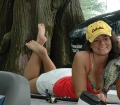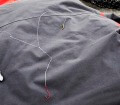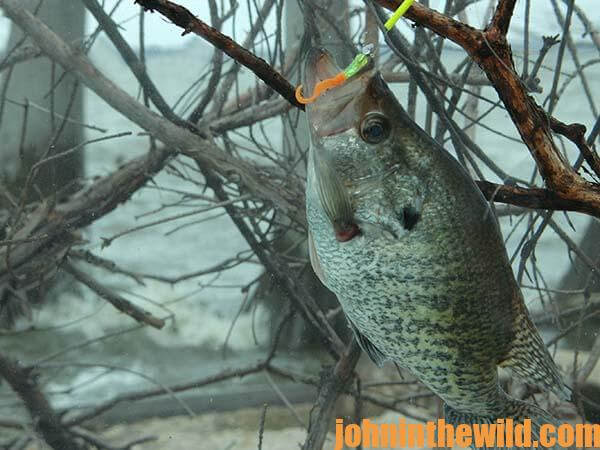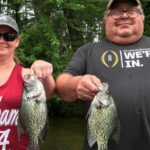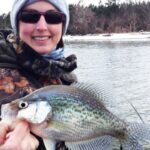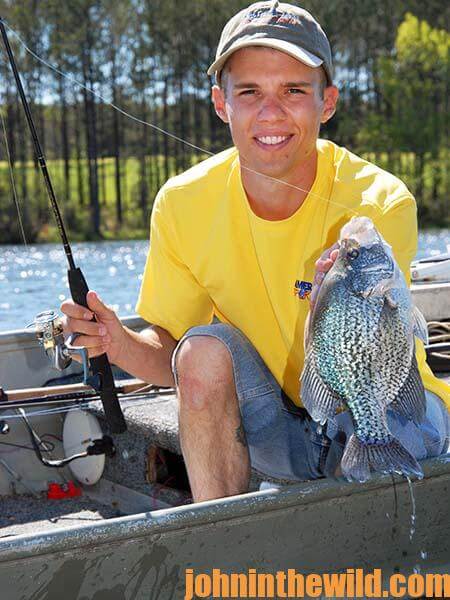 The three factors that will allow you to find and catch crappie all year long are water depth, water temperature and the amount of dissolved oxygen in the water.
The three factors that will allow you to find and catch crappie all year long are water depth, water temperature and the amount of dissolved oxygen in the water.
Most lakes and rivers stratify (have one temperature on the top layer of the water and a different temperature deeper in the water). For instance, in the spring, the shallow water that generally warms up first on any lake or river will begin to get warmer than the deep water. Crappie will follow the warmer water, until they find the right temperature to spawn. Black crappie like to spawn when the water temperature is between 58 – 68 degrees. The white crappie prefer to spawn when the water temperature is between 56 -72 degrees. As the water continues to warm into the summer, the crappie will move out into cooler water, usually to the places where they’ve been holding before the spawn. As the water gets really hot, they’ll go deeper to the creek and river channels.
The thermocline is where the hot and cool water meets. Often, there’s little or no dissolved oxygen below the thermocline. So, as the weather warms up, and the crappie go deeper, any place that you can find where the thermocline comes in contact with brush and cover or with a vertical drop like a ledge or a creek channel, often, this place is where you’ll find and catch your crappie. One of the questions we’re most often asked is, “How do you find the thermocline?” If you have a depth finder, the thermocline is easy to identify. There almost will be a line on your depth finder between the bottom and the surface, which is where most of the fish you see on your depth finder will be holding.
 One of the big mysteries for me always has been how you find the thermocline, if you don’t have a depth finder? This past weekend at the Crappie Maters Alabama Championship I learned the answer to this question. “If you’re fishing with minnows, and you let your minnows go down to or near the bottom, if you pull the minnows up, and they’re dead, then, you know you’re fishing below the thermocline,” Crappie pro Whitey Outlaw reports. “There wasn’t enough dissolved oxygen in the water.”
One of the big mysteries for me always has been how you find the thermocline, if you don’t have a depth finder? This past weekend at the Crappie Maters Alabama Championship I learned the answer to this question. “If you’re fishing with minnows, and you let your minnows go down to or near the bottom, if you pull the minnows up, and they’re dead, then, you know you’re fishing below the thermocline,” Crappie pro Whitey Outlaw reports. “There wasn’t enough dissolved oxygen in the water.”
Another debate that many crappie fishermen have is whether to use minnows, jigs or a combination of a jig tipped with a minnow. Most of the nation’s top crappie fishermen agree that the best way to make this decision is to fish all three baits and let the crappie decide which bait they like best. Also crappie tend to prefer different colors of jigs on various days, often, at different times of the day. So, how do you know what color jig will catch the most crappie on any day you fish, or at any time of the day? After polling several of the nation’s best crappie fishermen, the consensus is:
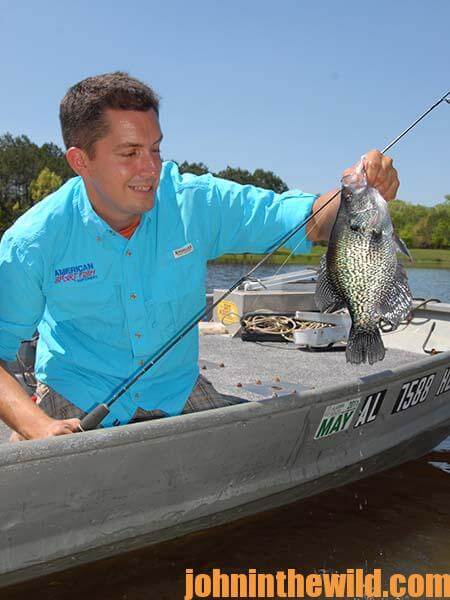 * in the early morning under low-light conditions, depending on water color, the crappie usually prefer darker-colored jigs like black, dark purple or green.
* in the early morning under low-light conditions, depending on water color, the crappie usually prefer darker-colored jigs like black, dark purple or green.
* as the sun comes up, and the crappie move higher in the water column, they usually prefer the lighter-colored jugs, like clear with red-and-blue flakes, a translucent chartreuse or white.
* under muddy water conditions, even early in the morning, the crappie may be in shallower water than usual, if you’re fishing a clear water lake. When the water is stained, bright colors like orange, bright red and florescent green seem to produce better.
Another critical factor for catching crappie is how fast the jig or the minnow is moving when the crappie takes it. If the crappie are feeding actively, they’ll take your baits as soon as they’re in front of them, or as soon as you troll by them. If they aren’t feeding actively, you may have to hold your jig or minnow as still as possible for the crappie to take the bait. If you watch minnows or bait fish in an aquarium, you’ll notice that they aren’t constantly moving. Often, the minnow and bait fish will suspend for several seconds or longer in one spot. They offer the crappie an easy meal that it doesn’t have to chase, if the fish comes in behind the minnow and sucks in the minnow. For this reason, if you troll over a school of crappie that you locate on your depth finder, let that minnow or jig sit as still as possible right in front of the crappie. Many times not moving the bait will trigger a strike.
One thing you can be sure about crappie is that there are no absolutes.
For more crappie fishing tips, get John E. Phillips’ Kindle eBooks “Crappie: How to Catch Them Fall & Winter,” “Crappie: How to Catch Them Spring and Summer,” “Catch Cold Water Crappie Now,” and “Reelfoot Lake: How to Fish for Crappie, Bass, Bluegills and Catfish & Hunt for Ducks.” Click here to get these books.
Share this page with a friend!
About the Author
John Phillips, winner of the 2012 Homer Circle Fishing Award for outstanding fishing writer by the American Sportfishing Association (ASA) and the Professional Outdoor Media Association (POMA), the 2008 Crossbow Communicator of the year and the 2007 Legendary Communicator chosen for induction into the National Fresh Water Hall of Fame, is a freelance writer (over 6,000 magazine articles for about 100 magazines and several thousand newspaper columns published), magazine editor, photographer for print media as well as industry catalogues (over 25,000 photos published), lecturer, outdoor consultant, marketing consultant, book author and daily internet content provider with an overview of the outdoors. Click here for more information and a list of all the books available from John E. Phillips

